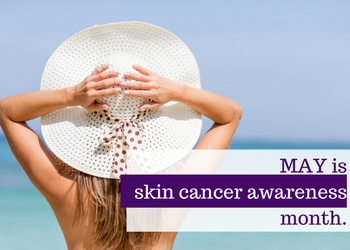Protecting Yourself Against Skin Cancer
Posted on
 Summer is on its way, which means more time spent outdoors. While getting fresh air and exercise is a great way to improve and maintain your health, there’s one thing about the summer sun that isn’t so positive: skin cancer.
Summer is on its way, which means more time spent outdoors. While getting fresh air and exercise is a great way to improve and maintain your health, there’s one thing about the summer sun that isn’t so positive: skin cancer.
May is Skin Cancer Awareness Month, and The Harold Leever Regional Cancer Center urges everyone to be aware of the risks and signs of skin cancer, and to take steps to protect themselves.
Types of Skin Cancer
Skin cancer is the most common type of cancer in the United States. In fact, more skin cancers are diagnosed in the United States every year than all other cancers combined.
Most skin cancers are non-melanoma types, which usually respond well to treatment and rarely spread to other parts of the body. Basal cell skin cancer is the most common type of non-melanoma skin cancer, accounting for about 80% of cases, followed by squamous cell skin cancer.
Melanoma is a much more rare and dangerous type of skin cancer, though the cure rate is close to 100% if detected and treated early. According to the National Cancer Institute, melanoma is the ninth most common cancer type in the United States, with an expected 91,270 new cases diagnosed in 2018.
Most melanomas (70%) are the superficial spreading type, which remain close to the surface of the skin for a fairly long time before spreading down to other parts of the body. Melanoma is usually treated with surgery to remove the melanoma, but more treatment may be required if the melanoma has spread.
Risks for Skin Cancer
Anyone can get skin cancer, but several factors can increase your risk of getting all types of skin cancer, including:
- Family history
- Unusual moles
- Exposure to sunlight
- Use of a tanning bed
- Sun sensitivity (burning easily or difficulty tanning)
- Natural blond or red hair color
- Weakened immune system
- Frequent sunburns
- The use of certain medications, such as steroids and BRAF inhibitors
- Previous treatment with radiation therapy
- Infection with the human papillomavirus (HPV)
What to Look For
Warning signs for all types of skin cancers include changes in the size, shape, or color of a mole or other skin lesion, the appearance of a new growth on the skin, or a sore that doesn’t heal.
Squamous cell carcinoma often appears as a lump with a rough surface or a flat, reddish patch. Basal cell carcinoma can appear as a flat growth, or a small shiny raised area that is pink or red and may bleed easily.
A melanoma may be indicated if a mole is asymmetrical, has an irregular border, is varied in color, is greater than 6mm in diameter, or is changing in size, shape, color, or texture.
Skin Cancer Prevention
While some skin cancer risk factors are beyond the individual’s control, according to 2017 data from the American Cancer Society, “many of the more than 5 million skin cancer cases that are diagnosed annually could be prevented by protecting skin from excessive sun exposure and not using indoor tanning devices.”
To guard against skin cancer, use sunscreen with an SPF of 15 or higher, limit exposure to the sun between the hours of 10 a.m. and 4 p.m., wear sun-protective clothing and sunglasses, and examine the skin regularly for any abnormal growths. For more on how to check your skin for signs of skin cancer, download the body mole map from the American Academy of Dermatology and see the American Cancer Society’s guide to checking your own skin.
Skin Cancer Resources
- American Academy of Dermatology
- Melanoma Research Foundation
- National Cancer Institute
- Skin Cancer Foundation
